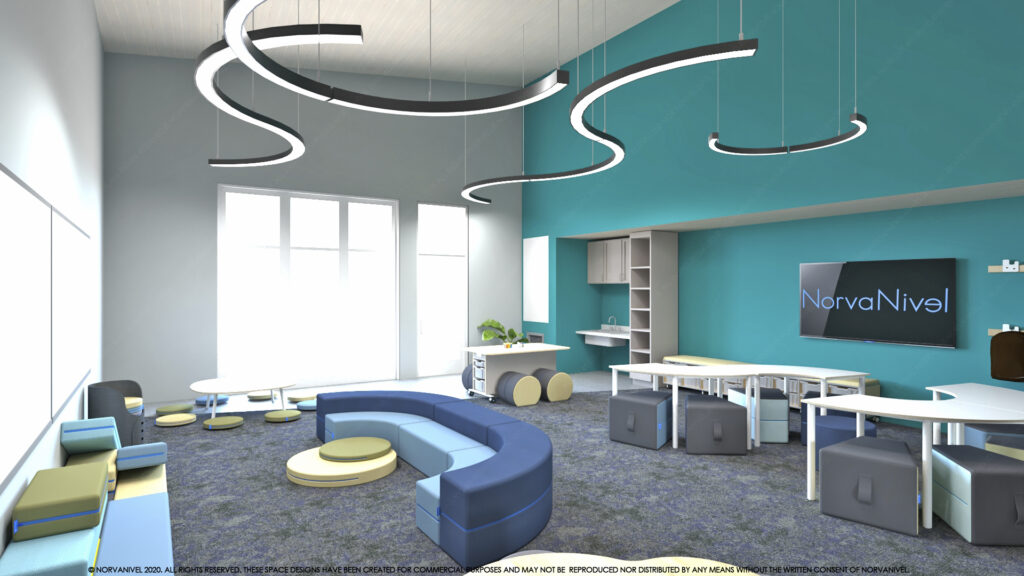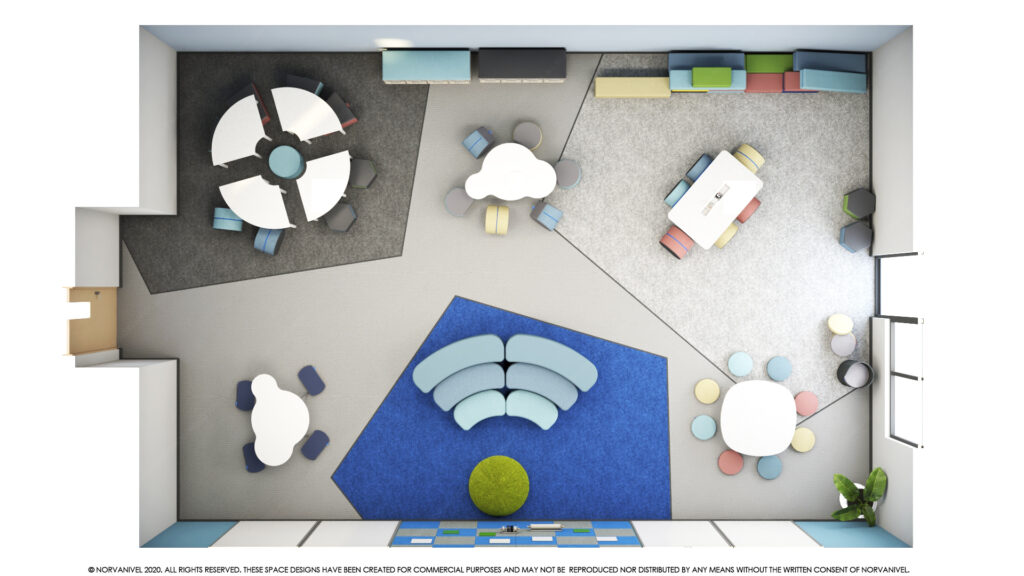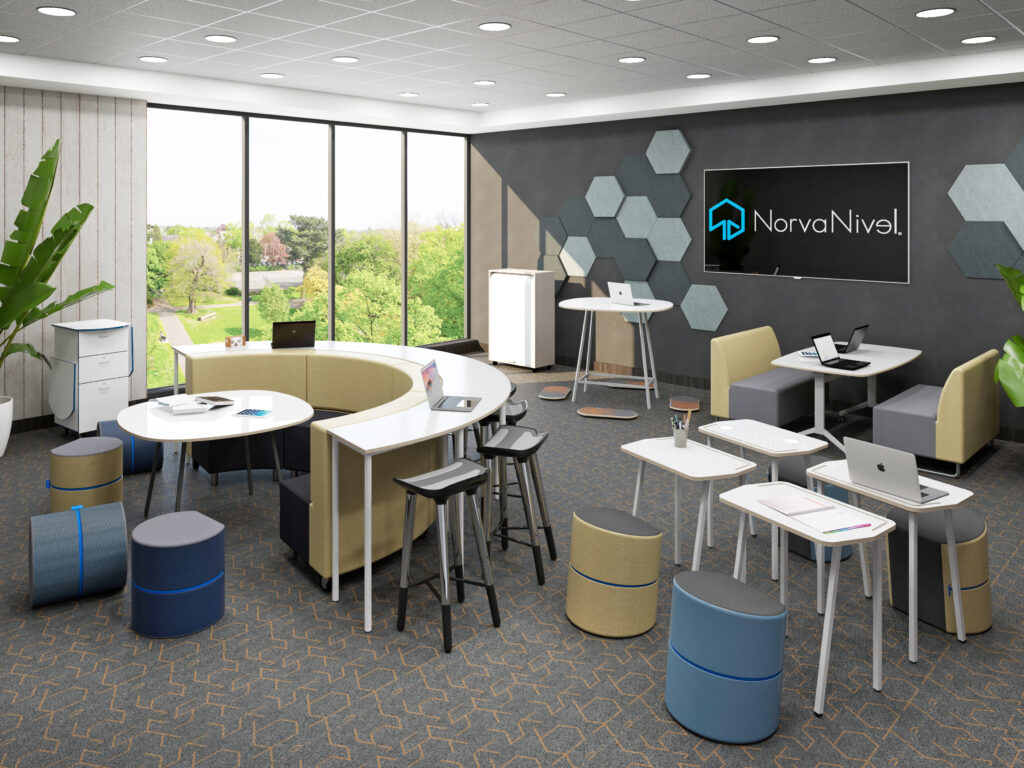In 1810, Johann Wolfgang von Goethe, expressed his subjective theory of colors for the first time. This theory is considered the birthplace of philosophical concepts such as color harmony, aesthetics, and the roles of light and dark within color recognition. Goethe, and the phenomena of color, have long been adapted to additional theories such as Color Theory and Color Psychology, however, each query only existed as a response to the work Goethe began.
We see the philosophy of color everywhere. From themed restaurants, sports teams, and maps… to corner wall spaces in 75% of K-12 learning spaces that emphasize emotional reflection and regulation. If you’re feeling upset, generally, you’d point to a red facial visual. The rate of acceptance of Color Psychology within learning environments is growing. So then, should the acceptance of Color Psychology within learning space design.
Introducing, Color
A major rule within the realm of environmental design is understanding the end user. And by extension, for the sake of this discussion, understanding how the end user responds to color. Although one would argue we don’t need to spend time comprehending subtractive and additive color models — a basic introduction of colors and the role of our Limbic System should suffice.

Key takeaways from Psychology Today assert:
- Colors can increase our visual memory and arousal level.
- The effect of emotions on memory can sometimes depend on color.
- We can use colors to brighten our days and make us feel better and healthier.
But what is color? Britannica scientifically describes color as: the aspect of any object that may be described in terms of hue, lightness, and saturation. In physics, color is associated specifically with electromagnetic radiation of a certain range of wavelengths visible to the human eye — the visible spectrum.
According to the article, How Colors Affect Brain Functioning 2023, “Color is an important stimulus for the brain because 80% of our sensory impressions come from our visual system. Research suggests that the pituitary gland, which is responsible for body temperature, energy level, sleep pattern, metabolism, and sexuality, is sensitive to color stimulation.” (Gurson, L. 1982 / Elliot, A. J, 2015)
As articulated by Datacolor in The Science Behind Color Perception, “Color is a sensory perception rather than a physical property that can be given a unit, and no two people experience color quite the same.” Now that we have a basic understanding of the color reception process, we can now look more closely at the connection between color and the Limbic System.
Knowing how people perceive color allows a more effective connection between learning design and learning communities.
Fight or Flight
The most basic description of the Limbic System is a “group of interconnected brain structures that help regulate your emotions and behavior. [The system] works together with other brain regions by processing your memory, thoughts and motivations, then tells your body how to respond.” (Cleveland Clinic, updated 2024).
In a nutshell, sensory receptors intake stimuli which are then communicated to the Limbic System. Based on associations, the Limbic System will send Fight or Flight signals throughout the brain causing positive or adverse reactions. For example, when someone says the word ‘pizza’, an individual associates the word with sensory reception and can visualize a pizza, smell a pizza, unearth a memory of eating pizza, and even taste pizza. The same process has been mapped based on color perception and association.

The National Institutes of Health specifies that researchers at the National Eye Institute (NEI) have decoded brain maps of human color perception. A study emphasized in the article, Envision Color: Activity Patterns in the Brain are Specific to the Color You See shares, “the researchers found that study participants had unique patterns of brain activity for each color.”
It’s important to note that color perception and its connection to the Limbic System impacts cognitive differences in contrasting ways. Aside from neuro function, it has been proven that ALL individuals associate color differently. The following list highlights how those in neurodivergent communities discern and associate colors. This is not a comprehensive list, however, it showcases many cognitive differences seen within most learning environments.

- Neurodiverse: 85% of neurodiverse students see colors more intensely — bright colors can be overwhelming and can lead to sensory overload. (Walturn, 2024)
- Autism Spectrum Disorder (ASD): Neutral tones and mellow colors have a calming and soothing effect and are considered autistic-friendly. On the other hand, bright, bold, and intense colors have a stimulating impact on the child. (Walturn, 2024) Many individuals with ASD experience Visual Defensiveness — the acuity of their vision can be overwhelming and confusing, so they need to turn away from whatever it is that’s overstimulating to them. (Amen Clinics, 2021)
- ADHD: Individuals with attention-deficit/hyperactivity disorder (ADHD) are reported to manifest visual problems (including ophthalmological and color perception, particularly for blue-yellow stimuli) (National Library of Medicine, 2015)
- Synesthesia: A person with synesthesia may associate certain letters and numbers with certain colors — they may simultaneously perceive colors as associated with or evoked by each one. (Science American, 2003) Individuals can often ‘see’ colors as associated with ‘taste’, ‘shape’, and ‘textures’ (Healthline, 2018)
- Sensory Processing Disorder (SPD): Many people with SPD have a difficult time processing brightness.
- Speech and Language Processing: Statistical analysis of reaction time data reveals that color affects the speed of naming vocabulary within the developmental range for a child. (American Journal of Speech-Language Pathology, 2000)
Which colors are best for learning spaces? Stick to the basics:
- Pastels, pastels, pastels!
- Earthy tones: mauve, plum, off white, tan, taupe
- Greens
- Blues
- Pinks

What are purposeful accent colors? Considering color perception differs for ALL, it’s important to choose generic accent colors that will have an overall motivating effect for both learners and facilitators. Accent colors should exist in spaces that can be added or removed based on activities and intended outcomes. These colors should not be a permanent object within the space but more incorporated within instructional learning materials:
- Basket
- Chart
- Manipulatives
- Language supports
The same theories and processes regarding color can be extended to other visual stimuli. (i.e. patterned fabric, wall clutter, visual resources, ceiling covers etc.) Ongoing research observes the effects of visual stimulus within learning environments. Research’s overall objective is to build connections which enhance learning experiences for everyone.
So, Now What?
Considering the 85+ articles written about the effects of color and visual stimuli since 2010, we can now more effectively design learning spaces that attract, immerse, and encourage learners. Knowing how people perceive color allows a more effective connection between learning design and learning communities.
A visual design has two functions: One is to support learners to process materials cognitively, and the other is to influence learners’ attitude and motivation effectively (Moreno, 2007; Plass, Heidig, Hayward, Homer & Um, 2014).
How can designs be created that assist processing and encourage motivation? By asking the following paramount questions:
- Which colors are associated with specific academic and socio-emotional outcomes? (see above examples)
- What type of educational setting is being designed? (general education, special education, specialty [lab, STEAM, performance etc.], high traffic [media center, cafeteria, commons etc.])
- What types of activities are taking place? What curriculum is being used?
The design of a learning space is so much more than dimensions, furniture, finishes, and installations.
Each of these factors contributes to learning space design. Without these considerations, a design may not be as equitable as it could be, consequently providing less of a worthwhile learning experience. These questions can and should be asked by all involved within a project. (school leadership, facilitators, learners, designers, project managers, distributors, manufacturers etc.) Without the use of these questions, color and visual choice is made with a singular focus, as opposed to working to understand how the learning space can best function.
Within the learning environment, perception and association vary for each person. These perceptions and associations are how individuals experience learning materials, relationships, curiosities, and achievements. Color is an integral part of creating those experiences. The design of a learning space is so much more than dimensions, furniture, finishes, and installations. It’s providing the foundation for an ecosystem to grow and flourish. And that’s a horse of a different color.
References
- Walturn, Unlocking Focus: How Color Palettes Can Help Neurodivergent Students Thrive
- National Library of Medicine: National Center for Biotechnology Information, Atypical Color Preference in Children with Autism Spectrum Disorder
- Psychology Today, How Colors Affect Brain Functioning
- Amen Clinics, How Does Visual Processing Impact Someone on the Autism Spectrum
- Science American, More Common Questions about Synesthesia
- Healthline, What is Synesthesia
- American Journal of Speech-Language Pathology, Effect of Color on Developmental Picture-Vocabulary Naming of 4-, 6-, and 8-Year-Old Children

